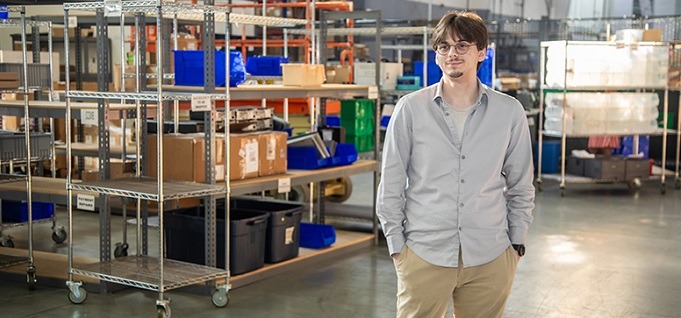Leveraging internships
By Leigh Keeton
March 6, 2024
Doyle Bain is the shining example in TRG’s internship program.
A year ago, he was a software development intern from Ohio’s Lorain County Community College (LCCC). As a configuration specialist, Bain spent his three months configuring smart phones and tablets for TRG’s customers. When the internship ended, he moved to part-time. Then full-time. Six months later, he was promoted to mobile device management engineer.
“Grateful really sums up my feelings about the internship I started at TRG,” Bain says. “Everybody was helpful and supportive in my journey from college to going on to full-time employment.”
A path to employment
Bain, 23, went from intern to full-time within one year. The speed, while impressive, doesn’t matter much to TRG President Sean Kennedy. It’s the path. And he wants more interns to follow it.
“TRG provides a next-level ability here where students can see a clear pathway from intern to part-time to full-time,” Kennedy says. “Our team has done a great job building that program with LCCC.”
Interns play a permanent, vital role in TRG’s employee recruitment, development and retention strategy. The program successfully funnels future full-time workers into the company, in part, because they feel welcome and valued from day one.
“We treat our interns as we treat our full-time employees,” Kennedy says. “We ingrain them in our culture. We teach them our core values. They come in and they’re part of the team.”
The internship program at TRG, which is a subsidiary of TruWest Holdings, is Deborah Santillo’s baby. It was born through a need she knew, as talent acquisition manager, was best filled by LCCC students. At any given time, the northeast Ohio company of 300 can have up to 10 LCCC interns. Santillo says they’re basically assigning TRG’s ongoing entry-level work to a consistent rotation of interns. And it’s working really well.
“It’s a win for us because we get these eager, inquisitive minds to teach, encourage and nurture,” Santillo says. “But it also gives these students a hands-on experience in a field that they’re studying.”
Skills for an evolving industry
Santillo knows that saying TRG is in “enterprise mobility” doesn’t mean much to most people. So, she explains it like this. Imagine a global company, like Nike, Delta Air Lines or JOANN Fabrics — all TRG customers — needs to issue hundreds of iPhones to its employees. All the phones need to be uniformly preconfigured so employees can simply power up and start working.
TRG does that. They do the same for tablets, barcode scanners and other point-of-sale devices. And that’s just one aspect. From device planning and deployment to repair and, ultimately, disposal, TRG can touch every point of a customer’s device lifecycle management services.
The repair part is where LCCC interns first came into play. Specifically, the college’s micro electromechanical mechanical systems (MEMS) students. The college’s MEMS students work with printed circuit boards and semiconductor chips — the brains inside the iPhones, tablets, and barcode scanners. They develop knowledge in computer science, electronics, soldering, chemistry and mechanics on a microscopic scale. And they walk through TRG’s doors ready to go.
“LCCC does a great job preparing their students,” Santillo says. “We’re set up to succeed with them because LCCC has laid that foundation.”
That foundation, as Santillo describes it, stands strong because of the way LCCC approaches its education and training. It’s hands-on and industry-led. And it sets LCCC students apart.
“LCCC’s MEMS programs were built in partnership with more than 30 local companies, like TRG,” says MEMS program director Johnny Vanderford. “That close relationship with industry ensures that every class teaches students exactly what those companies want employees to know on the job.”
Learning to keep pace
Norah Ali, 25, is a student in the associate of applied science in MEMS. She’s in her second semester but started her TRG internship preparing scanning devices after taking just one course. As Ali continued her education and internship, the two areas seemed to follow perfectly synced parallel paths.
“Everything I was learning about MEMS at LCCC started to make even more sense,” Ali says. “I realized that I knew a lot more than I thought I did.”
Ali knows the evolving industry will require constant learning to keep pace, so she plans to enroll in LCCC’s bachelor of applied science in MEMS after earning the associate degree. And she can apply every skill she learns to her work at TRG. She accepted a part-time position as soon as her internship ended.
“At TRG you have the option to grow with them as you learn more through classes,” she says.
Expanding its intern pool
“When we find something successful, we don’t just let it lie,” Santillo says.
The TRG team found so much value in the MEMS internship program, Santillo decided to broaden its intern pool. She landed on software development and cybersecurity students. These information technology interns help with the configuration part of TRG’s offerings.
Hannah Liddy, 19, is studying cyber security at LCCC. Matthew Szlempa, 20, is in the software development program. Both say the team-focused environment TRG has built makes it easy to collaborate, ask questions and learn from others. And both accepted part-time roles with the company in August 2023.
To increase the intern momentum, Santillo and Kennedy made another commitment to LCCC students. The pair teamed with leaders from the LCCC Foundation to start a scholarship program. It’s solely for LCCC students who complete their internships at TRG.
“We know students are trying to go to school in an affordable way and this program helps them fund their education,” Santillo says. “It was another way that we could make our employees stronger, strengthen that partnership with LCCC, and continue to grow the internship program.”
This article originally appeared in CC Daily.



